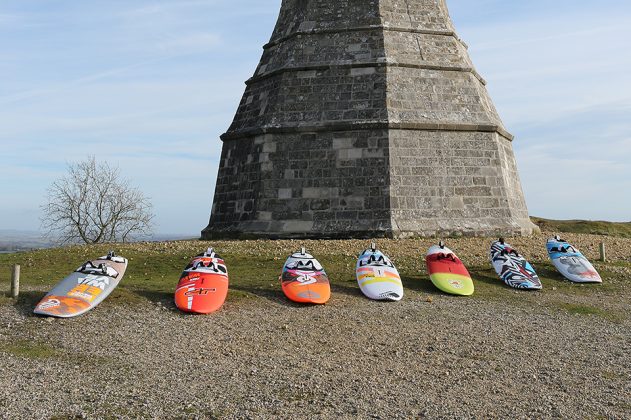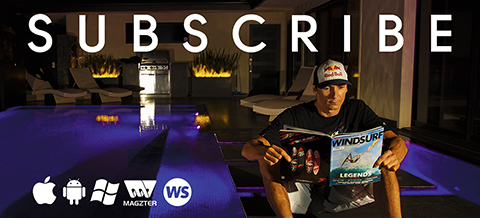THE PINNACLE OF VERSATILITY
105L CROSSOVER BOARD TEST 2017
Test Editor Tris Best // Second Testers Maurin Rottenwalter & Joe North
Photos Maurin Rottenwalter // Test location Ringstead & Portland Harbour
“Forget small high wind freeride boards or large light wind wave boards … the freestyle-wave path is the ideal option for 99% of coastal-sailing recreational windsurfers.” This is likely to be a familiar sales patter for many, and up until the recent past, was undoubtedly very true. A multi-discipline board is, of course, not a new concept. Ever since the dawn of the funboard, brands have tried to produce and market a board with that extra little touch of magic that would serve to eclipse the competition. And there have been some stand out winners in the sport’s short history – the F2 Sunset Slalom, Mistral Screamer, Tiga 260, the original Fanatic Gecko… All classics of their era. The mere mention of their names has no doubt got some of you reading this reminiscing of your most memorable moments on the water.
This test was originally published in the January/February 2017 issue.
The ‘freestyle wave’ movement was a phenomenon that took hold at the turn of the century, when the freestyle discipline exploded onto the scene, providing a means for the sport to reinvent itself as an ‘extreme’ sport on flat water, and enable a new breed of pioneers to touch otherwise untouchable corners of the globe. Lakes in Austria and Italy played host to massive freestyle events, where the sport’s elite could take the sharp end of development right to the people, hoping to inspire a new generation. The competition was tangible and intimate, the kit colourful and the new moves exciting. And the ‘freestyle wave’ discipline simply erupted, viewed as an easy sell in terms of encouraging people to have a go at the new discipline, whilst keeping a foothold in a discipline they were familiar with.
Today, in design terms, the title ‘freestyle wave’ is a bit of an oxymoron. Just as the name ‘wave-slalom’ (the description used in late eighties, early nineties) found out before it, developments in disciplines move on, shining a spotlight on the crossover discipline’s compromises and shortcomings. Since freestyle’s heady days, both freestyle and wave sailing have evolved under the guidance of influential sailors, pushing their own limits (and in doing so, the sport’s perceived boundaries). This has resulted in the requirements put upon their equipment becoming more defined … even polarised. Specialist items have appeared … freestyle boards with enlarged voluminous tails, wave boards with wingers, channels and numerous fins in their tail. And this divergence in equipment requirements has created a bit of a nametag dilemma.
To be an accomplished freestyle platform, a board must have minimal rocker, hard boxy rails and lots of volume for pop in the tail. A wave board on the other hand has completely the opposite – a thin narrow tail, tapered soft rails and plenty of rocker. So if ‘freestyle wave’ is no longer relevant (despite being the actual name used for their boards by both JP and RRD) what title best describes this category? Has the ‘do-it-all-board’ fallen foul of the old adage ‘jack of all trades’ and become the master of none? Is it simply a bit of a compromised ‘Billy punter’ option … a high wind freeride board that the progressing rider would soon grow out of? Well, we’re pleased to say no. The fact is, many brands seem to have seen the writing on the wall for the FSW epithet, and have long since used other tags to describe their offerings. Freewave seems to be the most commonly used term, and for many of the boards here, it fits the bill nicely. But looking at some designs in this group is change afoot once again?
FINDINGS
Multi-fins hit the crossover scene in earnest last year and 2017 sees that trend continue. If the board isn’t supplied as a multi-fin as standard, it has the boxes incorporated to enable it to be set up as one, should you wish. In fact, of the seven boards on test here, only one is a dedicated single-fin. The reality is: multi-fin options extend a board’s tune-ability, and let’s face it – fin boxes are light enough today to mitigate any downside to including them in the board’s tail. Nevertheless, if a board is designed specifically to be single-fin only, that is not to say it will be a dud in the waves. After all, it wasn’t too long ago that every single wave board was a single-fin and it didn’t stop the sport’s pioneers charging the largest waves or developing iconic riding styles. And as with all things … they’ll no doubt come back into vogue in the future…
An interesting development seen this year in the crossover board category is the introduction of ‘compact’ designs. Call them what you will (the brands have!) – stubbies, compact designs, COTANs … they are the latest developments in wave board design, and it was only going to be a matter of time before the concept filtered down into the crossover board melting pot. Their inclusion has led to a large gulf opening up in measurements such as tail width. Whilst more conventional designs have narrow, tapered tail shapes, the new Compact designs retain wide tails, to account for the rider’s stance being moved right to the back. The wide nose helps to maintain balance and stability at idle and square overall outline enables the maximum width to be reduced, cleaning up the board’s waterline and increasing speed. Early planing and exciting, yet stable and forgiving, they go upwind like a rocket, yet offer instant response as the rider’s stance is right over the fin. What’s not to like? Well, the truth is, they won’t be everyone’s cup of tea. For some, that rearward stance will feel too unfamiliar and nervous … and for many, the compact board just looks too boxy and chunky … ugly even! But here’s a thought – shorter lengths mean less swing weight; square extremities and chunkier rails could be good precursors for more pop and reverse sliding stability, not to mention the advantages of early planing, speed, stability and upwind potential. So our question is this: has the birth of the compact crossover board seen the rejuvenation … redefinition even … of the true ‘freestyle-wave’ concept? The merits of compact designs have proven themselves in the wave arena and looking at Tabou and Fanatic here, we don’t think the potential for the concept in freestyle terms has yet been fully discovered. But the potential is undoubtedly there and as with everything, we are sure that time will tell, as it always does.
SUMMARY
Lets start with the two ‘compact’ designs in the group. The FreeWave STB from Fanatic displays many of the virtues of a stubby design – stability at rest, early planing and low planing threshold, plus the responsive manoeuvring in tight spots with everything pivoting on the tail. It certainly has wave-sailing bias and will not be everyone’s cup of tea, particularly when the wind increases, but then there’s the much loved FreeWave still in the Fanatic line-up for that. The 3S from Tabou is a bold endeavour, again showing stability, early planing ease and upwind prowess. It has more aptitude in a straight-line than its compact counterpart and has a more involving nature, but you get what you put in with the 3S and it is a true bump and jump champion. The Goya One has a lively active wave-oriented character, excelling in float-and-ride, right up to medium sized waves; the Quatro boasting a similar capacity but with a more conventional feel. The RRD is all about plug and play ease, rising up onto the plane as if it is controlled remotely, and cushioning the hardest sea states effortlessly. Comfortable in any environment, it is effectively a high wind freeride board that will compliment any riding style with minimal fuss. That leaves the Starboard and JP. Two super tuneable boards, whose characters can be altered dramatically by playing with their fin set up. The JP has a more traditional feel, whilst the Starboard is right at the forefront of what is possible, technology wise. The best bit of advice we can give when using any of these boards is be prepared to experiment with fins, footstrap placements and deck plate position – you’ll be amazed at just where you can take them and what is possible on them.
THE LINE UP
• RRD FREESTYLE WAVE V4 104 LTD


